ECO mode Citroen JUMPY 2016 2.G Owner's Manual
[x] Cancel search | Manufacturer: CITROEN, Model Year: 2016, Model line: JUMPY, Model: Citroen JUMPY 2016 2.GPages: 595, PDF Size: 12.47 MB
Page 5 of 595
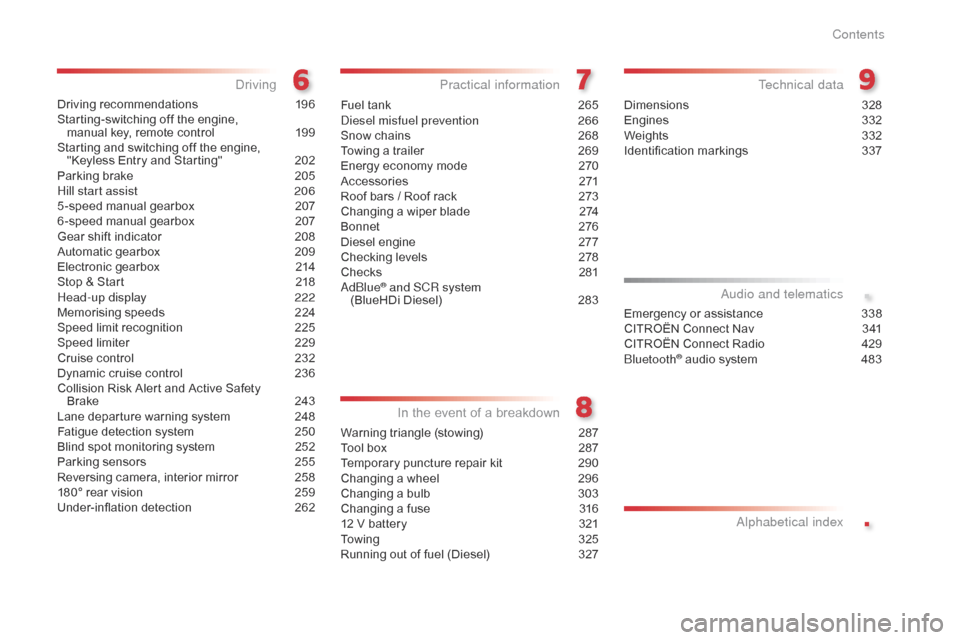
.
.
Jumpy _en_Chap00a_sommaire_ed01-2016
Driving recommendations 196
Starting-switching off the engine, manual key, remote control
1
99
Starting and switching off the engine, "Keyless Entry and Starting"
2
02
Parking brake
2
05
Hill start assist
2
06
5 -speed manual gearbox
2
07
6 -speed manual gearbox
2
07
Gear shift indicator
2
08
Automatic gearbox
2
09
Electronic gearbox
2
14
Stop & Start
2
18
Head-up display
2
22
Memorising speeds
2
24
Speed limit recognition
2
25
Speed limiter
2
29
Cruise control
2
32
Dynamic cruise control
2
36
Collision Risk Alert and Active Safety Brake
2
43
Lane departure warning system
2
48
Fatigue detection system
2
50
Blind spot monitoring system
2
52
Parking sensors
2
55
Reversing camera, interior mirror
2
58
180° rear vision
2
59
Under-inflation detection
2
62Fuel tank
2 65
Diesel misfuel prevention 26
6
Snow chains
2
68
Towing a trailer
2
69
Energy economy mode
2
70
Accessories
2
71
Roof bars / Roof rack
2
73
Changing a wiper blade
2
74
Bonnet
2
76
Diesel engine
2
77
Checking levels
2
78
Checks
2
81
AdBlue
® and SCR system
(BlueHDi Diesel) 2 83
Warning triangle (stowing)
2
87
Tool box
2
87
Temporary puncture repair kit
2
90
Changing a wheel
2
96
Changing a bulb
3
03
Changing a fuse
3
16
12 V battery
3
21
Towing
325
R
unning out of fuel (Diesel)
3
27Dimensions
3
28
Engines
3
32
Weights
3
32
Identification markings
3
37
Driving
Practical information
In the event of a breakdown Technical data
Emergency or assistance 3
38
CITROËN Connect Nav 3 41
CITROËN Connect Radio
4
29
Bluetooth
® audio system 4 83
Audio and telematics
Alphabetical index
Contents
Page 12 of 595
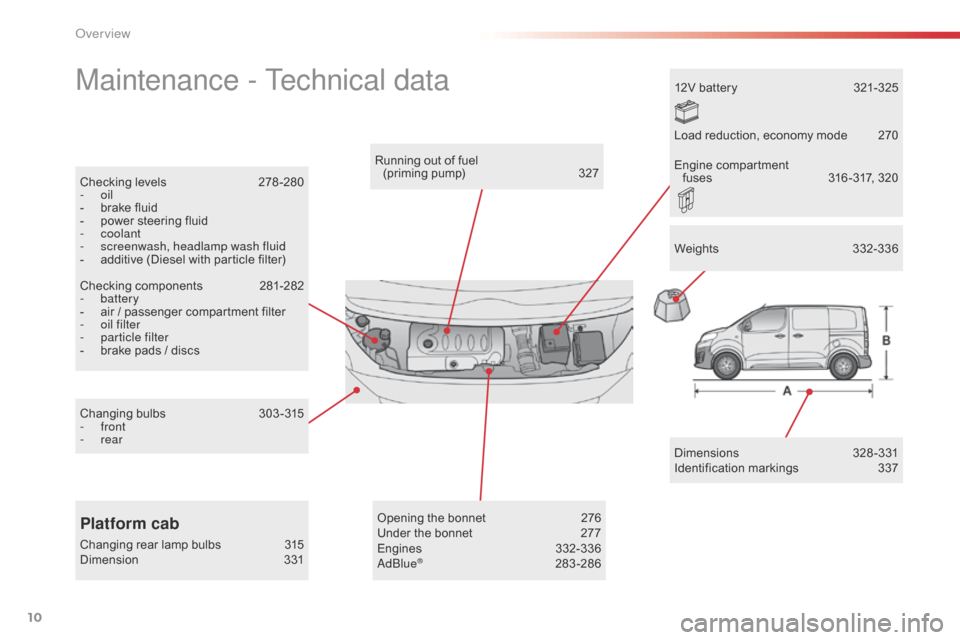
10
Jumpy _en_Chap00b_vue-ensemble_ed01-2016
Maintenance - Technical data
Dimensions 328-331
Identification markings 3 37
Running out of fuel
(priming pump)
3
27
Checking levels
2
78 -280
-
oil
-
b
rake fluid
-
p
ower steering fluid
-
coolant
-
s
creenwash, headlamp wash fluid
-
a
dditive (Diesel with particle filter)
Checking components
2
81-282
-
battery
-
a
ir / passenger compartment filter
-
o
il filter
-
p
article filter
-
b
rake pads / discs
Changing bulbs
3
03-315
-
front
-
rear
Platform cab
Changing rear lamp bulbs 3
15
Dimension 3 31 12V battery
3
21-325
Opening the bonnet
2
76
Under the bonnet 2 77
Engines 3 32-336
AdBlue® 28 3-286Weights
33
2-336
Load reduction, economy mode
2
70
Engine compartment
fuses
3
16 -317, 320
Over view
Page 14 of 595

12
Jumpy _en_Chap00c_eco-conduite_ed01-2016
Eco-driving is a range of everyday practices
that allow the motorist to optimise their fuel
consumption and CO
2 emissions.
Eco-driving
Optimise the use of your
gearbox
With a manual gearbox, move off gently and
change up without waiting. During acceleration
change up early.
With an automatic or electronic gearbox,
give preference to automatic mode and avoid
pressing the accelerator pedal heavily or
suddenly.
The gear shift indicator invites you to engage
the most suitable gear: as soon as the
indication is displayed in the instrument panel,
follow it straight away.
For vehicles fitted with an electronic or
automatic gearbox, this indicator appears only
in manual mode.
Drive smoothly
Maintain a safe distance between vehicles, use
engine braking rather than the brake pedal,
and press the accelerator progressively. These
practices contribute towards a reduction in fuel
consumption and CO
2 emissions and also help
to reduce the background traffic noise.
If your vehicle has cruise control, make use of
the system at speeds above 25 mph (40 km/h)
when the traffic is flowing well.
Control the use of your
electrical equipment
Switch off the demisting and defrosting controls,
if not automatic.
Switch off the heated seat as soon as possible.
Switch off the headlamps and front foglamps
when the level of light does not require
their
u
se.
Avoid running the engine before moving off,
particularly in winter; your vehicle will warm up
much faster while driving.
As a passenger, if you avoid connecting
your multimedia devices (film, music, video
game...), you will contribute towards limiting the
consumption of electrical energy, and so of fuel.
Disconnect your portable devices before
leaving the vehicle.
Before moving off, if the passenger compartment is
too warm, ventilate it by opening the windows and
air vents before using the air conditioning.
Above 30 mph (50 km/h), close the windows and
leave the air vents open.
Remember to make use of equipment that can
help keep the temperature in the passenger
compartment down (sunroof and window blinds...).
Switch off the air conditioning, unless it has
automatic regulation, as soon as the desired
temperature is attained.
Eco-driving
Page 19 of 595
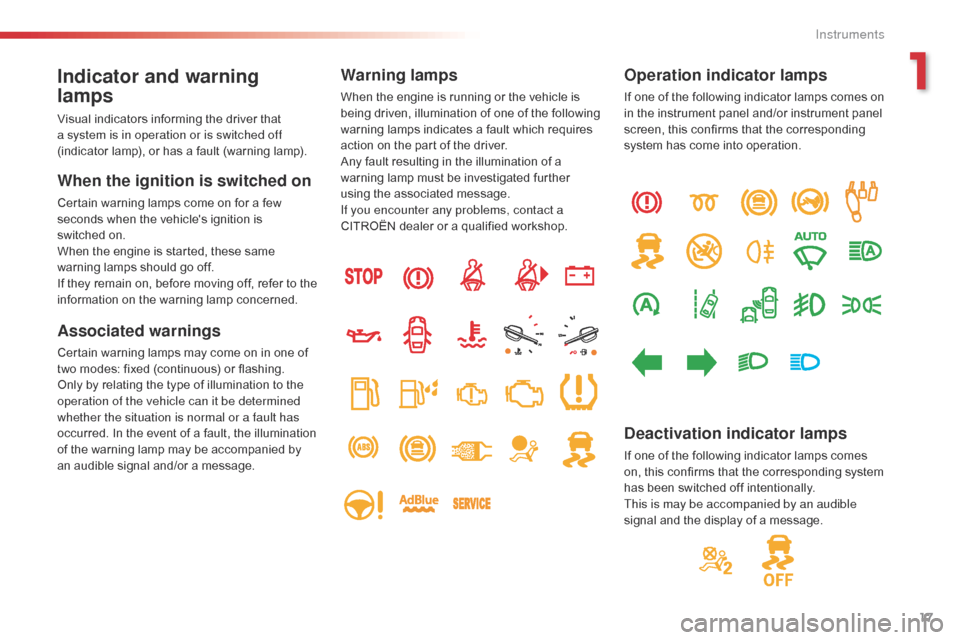
17
Jumpy _en_Chap01_instruments-de-bord_ed01-2016
Indicator and warning
lamps
Visual indicators informing the driver that
a system is in operation or is switched off
(indicator lamp), or has a fault (warning lamp).
When the ignition is switched on
Certain warning lamps come on for a few
seconds when the vehicle's ignition is
switched on.
When the engine is started, these same
warning lamps should go off.
If they remain on, before moving off, refer to the
information on the warning lamp concerned.
Associated warnings
Certain warning lamps may come on in one of
two modes: fixed (continuous) or flashing.
Only by relating the type of illumination to the
operation of the vehicle can it be determined
whether the situation is normal or a fault has
occurred. In the event of a fault, the illumination
of the warning lamp may be accompanied by
an audible signal and/or a message.
Warning lamps
When the engine is running or the vehicle is
being driven, illumination of one of the following
warning lamps indicates a fault which requires
action on the part of the driver.
Any fault resulting in the illumination of a
warning lamp must be investigated further
using the associated message.
If you encounter any problems, contact a
CITROËN dealer or a qualified workshop.
Operation indicator lamps
If one of the following indicator lamps comes on
in the instrument panel and/or instrument panel
screen, this confirms that the corresponding
system has come into operation.
Deactivation indicator lamps
If one of the following indicator lamps comes
on, this confirms that the corresponding system
has been switched off intentionally.
This is may be accompanied by an audible
signal and the display of a message.
1
Instruments
Page 31 of 595

29
Jumpy _en_Chap01_instruments-de-bord_ed01-2016
Warning / indicator lampStateCause Action / Observations
Automatic
wiping fixed.
The wiper control has been pushed
down. Automatic front wiping is activated.
To deactivate automatic wiping, operate the control
stalk downwards or put the stalk into another position.
Automatic
headlamp
dipping fixed.
The lighting control stalk is in
the
"AUTO " position, and the function
has been activated.
The main beam headlamps come
on if the exterior lighting and driving
conditions permit. The camera, located at the top of the windscreen,
manages the operation of main beam, depending on
the ambient lighting and driving conditions.
For more information on Automatic headlamp
dipping
, refer to the corresponding section.
Stop & Star t fixed. When the vehicle stops (red lights,
traffic jams,
...) the Stop & Start
system has put the engine into STOP
mode. The warning lamp goes off and the engine restarts
automatically in START mode, as soon as you want to
move off.
flashes for a few
seconds, then goes
of f. STOP mode is temporarily
unavailable,
or
START mode is invoked
automatically. For more information on Stop & Star t
, refer to the
corresponding section.
Blind spot
monitoring
system fixed.
The blind spot monitoring system has
been activated. For more information on the Blind spot monitoring
system, refer to the corresponding section.
Lane departure
warning system
fixed.
The lane departure warning system
has been activated. The lane departure warning system is on.
For more information on the Lane departure warning
system, refer to the corresponding section.
1
Instruments
Page 44 of 595

42
A few definitions
Range
(miles or km)
The distance which can still be
travelled with the fuel remaining in
the tank (related to the average fuel
consumption over the last few miles
(kilometres) travelled).
This value may vary following a change
in the style of driving or the relief,
resulting in a significant change in the
current fuel consumption.
When the range falls below 20 miles (30 km),
dashes are displayed. After filling with at least
8 litres of fuel, the range is recalculated and is
displayed when it exceeds 60 miles (100 km). If dashes are displayed continuously
while driving in place of the digits,
contact a CITROËN dealer or a
qualified workshop. This function is only displayed from
20 mph (30 km/h).
Current fuel consumption
(mpg or l/100 km or km/l)
Calculated over the last few seconds.
Average fuel consumption
(mpg or l/100 km or km/l)
Calculated since the last trip reset.
Average speed
(mph or km/h)
Calculated since the last trip reset.
Distance travelled
(miles or km)
Calculated since the last trip reset.
Stop & Start time counter
(minutes / seconds or hours /
minutes)
If your vehicle is fitted with Stop & Start, a time
counter calculates the time spent in STOP
mode during a journey.
It resets to zero every time the ignition is
switched on.
Instruments
Page 86 of 595

84
Jumpy _en_Chap02_ouvertures_ed01-2016
General
recommendations
The doors must only be operated when
the vehicle is stationary.
For your safety and for that of your
passengers, as well as for correct
operation of the doors, you are strongly
advised not to drive with a door open.
Always check that it is safe to operate
the door and in particular, be sure not to
leave children or animals near the door
controls without supervision.
The audible warning, illumination of
the "door open" warning lamp and the
message in the multifunction screen
are there to remind you. Contact
a CITROËN dealer or a qualified
workshop to deactivate these warnings.
Lock your vehicle when using an
automatic car wash.Before any opening or closing and
during any movement of the doors,
ensure that no person, animal or object
is protruding through the window
frame or might prevent the intended
manoeuvre, either inside or outside the
vehicle.
If this advice is not followed, injuries or
damage may occur if a person or an
object is trapped or caught.
Electric closing and opening of the
doors is not possible above 2 mph
(3
km/h):
-
I
f you set off with the door(s) open,
you must slow down to below
20
mph (30 km/h) in order to close
the door(s).
-
A
ny attempt to open a door
electrically using the interior handle
while driving, results in only being
possible to open the door manually.
-
T
his situation is accompanied by
the audible warning, illumination of
the "door open" warning lamp and
the message in the multifunction
screen. To release the door and
be able to operate it again, it is
necessary to stop the vehicle.
Manual or electric sliding side door(s)
The electric controls are inhibited in the
event of an impact. Manual opening and
closing remain possible.
While starting the engine, the
movement of a door is interrupted and
restored once the engine is running.
Depending on the engine, in Stop
mode of Stop & Start, if the door
is closed and you initiate opening
of the door, the door opens
partially and stops. When the
engine changes automatically to
Start mode, the door continues its
movement.
Access
Page 100 of 595
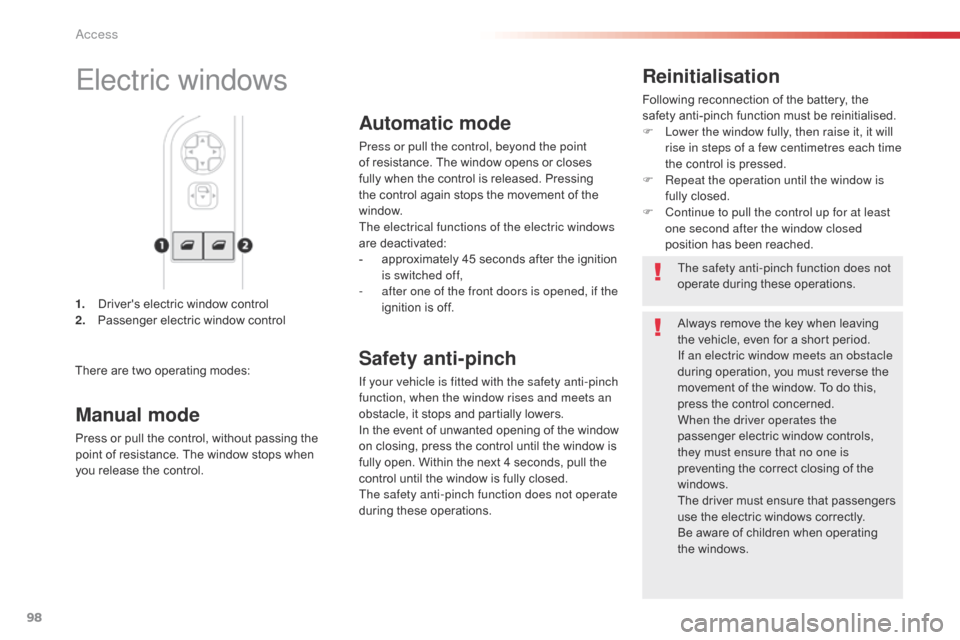
98
Jumpy _en_Chap02_ouvertures_ed01-2016
1. Driver's electric window control
2. Passenger electric window control
Reinitialisation
Following reconnection of the battery, the
safety anti-pinch function must be reinitialised.
F
L
ower the window fully, then raise it, it will
rise in steps of a few centimetres each time
the control is pressed.
F
R
epeat the operation until the window is
fully closed.
F
C
ontinue to pull the control up for at least
one second after the window closed
position has been reached.Electric windows
There are two operating modes: The safety anti-pinch function does not
operate during these operations.
Always remove the key when leaving
the vehicle, even for a short period.
If an electric window meets an obstacle
during operation, you must reverse the
movement of the window. To do this,
press the control concerned.
When the driver operates the
passenger electric window controls,
they must ensure that no one is
preventing the correct closing of the
windows.
The driver must ensure that passengers
use the electric windows correctly.
Be aware of children when operating
the windows.
Manual mode
Press or pull the control, without passing the
point of resistance. The window stops when
you release the control.
Automatic mode
Press or pull the control, beyond the point
of resistance. The window opens or closes
fully when the control is released. Pressing
the control again stops the movement of the
window.
The electrical functions of the electric windows
are deactivated:
-
a
pproximately 45 seconds after the ignition
is switched off,
-
a
fter one of the front doors is opened, if the
ignition is off.
Safety anti-pinch
If your vehicle is fitted with the safety anti-pinch
function, when the window rises and meets an
obstacle, it stops and partially lowers.
In the event of unwanted opening of the window
on closing, press the control until the window is
fully open. Within the next 4 seconds, pull the
control until the window is fully closed.
The safety anti-pinch function does not operate
during these operations.
Access
Page 130 of 595

128
Jumpy _en_Chap03_ergonomie-et-confort_ed01-2016
A setting around 21 enables you to
obtain an optimum level of comfort.
Depending on your requirements, a
setting between 18 and 24 is usual.
In addition, it is recommended that you
avoid a left /right setting difference of
more than 3.
Dual-zone automatic air conditioning
Offers the best compromise between
a comfortable temperature and quiet
operation.
Provides soft and quiet operation by
limiting air flow. Provides strong and effective air flow.
F
P
ress the "AUTO"
button
repeatedly.
Automatic comfort mode TemperatureF Push the button down to
reduce the value or up to
increase it.
When the engine is cold, the air flow will
only reach its optimum level gradually
to prevent too great a distribution of
cold air.
In cold weather, it favours the
distribution of warm air to the
windscreen, the side windows and the
footwells only.
The active mode appears in the display screen,
as described below:
If desired, you can choose settings different
to those offered by the system, by adjusting a
setting manually. The other functions are still
managed automatically.
The "AUTO " symbol disappears if you modify
a setting.
Manual mode
The driver and front passenger can each set
the temperature to suit their requirements.
The value indicated in the screen corresponds
to a level of comfort and not to a temperature in
degrees Celsius or Fahrenheit.
Ease of use and comfort
Page 164 of 595
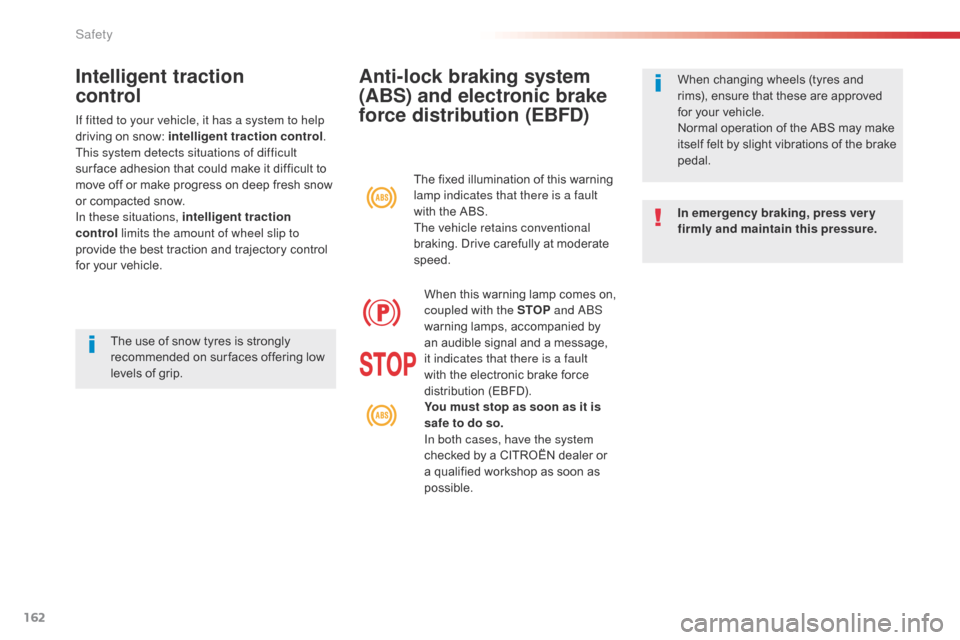
162
Jumpy _en_Chap05_securite_ed01-2016
Anti-lock braking system
(ABS) and electronic brake
force distribution (EBFD)
In emergency braking, press ver y
firmly and maintain this pressure. When changing wheels (tyres and
rims), ensure that these are approved
for your vehicle.
Normal operation of the ABS may make
itself felt by slight vibrations of the brake
pedal.
The fixed illumination of this warning
lamp indicates that there is a fault
with the ABS.
The vehicle retains conventional
braking. Drive carefully at moderate
speed.
When this warning lamp comes on,
coupled with the STOP and ABS
warning lamps, accompanied by
an audible signal and a message,
it indicates that there is a fault
with the electronic brake force
distribution (EBFD).
You must stop as soon as it is
safe to do so.
In both cases, have the system
checked by a CITROËN dealer or
a qualified workshop as soon as
possible.
Intelligent traction
control
If fitted to your vehicle, it has a system to help
driving on snow: intelligent traction control .
This system detects situations of difficult
sur face adhesion that could make it difficult to
move off or make progress on deep fresh snow
or compacted snow.
In these situations, intelligent traction
control limits the amount of wheel slip to
provide the best traction and trajectory control
for your vehicle.
The use of snow tyres is strongly
recommended on sur faces offering low
levels of grip.
Safety